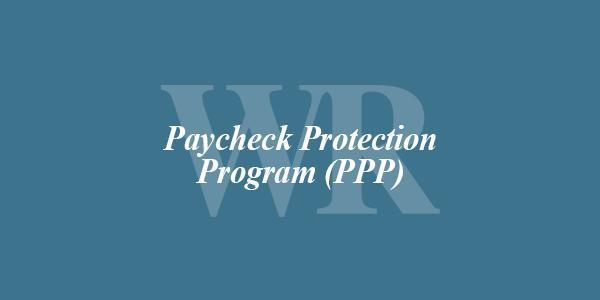
CARES Act Relief Fund Attestation Portal is now open
April 21, 2020
SC Business Personal Property tax filing dates
April 23, 2020Accounting for PPP Loans

As we continue to work with clients to put together their Paycheck Protection Program (PPP) loan applications in hopes the government will soon authorize additional funding and begin processing new loans, many of our clients have already received their PPP funds. Mid-week last week we began coaching clients through the forgiveness and accounting aspects of their loans. While we are still waiting on guidance to clarify the forgiveness metrics (here’s a good article from Forbes last week on what we need to know about PPP loan forgiveness), we have shared some recommended bookkeeping entries to help clients account for the loan. While there are multiple ways you could handle these in your system, below are a couple of our recommended approaches. If you have questions or would like to vet your approach to accounting for these loans, please call us and we can help.
Recommended bookkeeping entries for SBA PPP loan when funds are in an existing operating account:
- When the loan proceeds are received.
- Debit the bank account that the funds are deposited.
- Credit a new current liability account (Example: Note Payable SBA PPP Loan “Name of Bank”)
- When you pay qualified expenses with the loan proceeds.
- Debit the appropriate expense account for these expenditures.(rent, interest, compensation etc.)
- Credit the bank account used to pay the expenses.
- For each expense make sure that you fully document your calculation for the incurred period.
- We recommend scanning the documentation for each line item and saving those files in a separate network folder.
- Some people will be more comfortable keeping a spreadsheet noting the file name of the backup for each line item.
- When the loan is forgiven.
- Debit the current liability account Note Payable SBA Loan “Name of Bank” for the amount that is forgiven.
- Credit a new Miscellaneous Income account for the amount of the loan proceeds that are forgiven (Example: Miscellaneous Income – PPP Loan).
- If there is any amount of the loan that is not forgiven, the balance left in the Note Payable SBA PPP Loan “Name of Bank” will reflect the amount to be paid back, with interest.
Recommended bookkeeping entries for SBA PPP loan when funds are being put into a new checking account established for PPP funds:
- When the loan proceeds are received.
- Debit the bank account that the PPP funds were initially deposited into. (typically the standard operating account)
- Credit a new current liability account (Example: Note Payable SBA PPP Loan “Name of Bank”)
- Transfer the PPP funds out of the standard operating account and into the new PPP checking account.
- When you pay qualified expenses with the loan proceeds.
- Debit the appropriate expense account for the expenditures. (rent, interest, compensation etc.)
- Credit the bank account used to pay the expenses. (typically the standard operating account)
- Transfer the qualified expense amount out of the PPP checking account into the standard operating checking account.
- This way you have a line by line record of all qualified expenses paid using the PPP funds.
- For each expense make sure that you fully document your calculation for the incurred period.
- We recommend scanning the documentation for each line item and saving those files in a separate network folder.
- Some people will be more comfortable keeping a spreadsheet noting the file name of the backup for each line item.
- When the loan is forgiven.
- Debit the current liability account Note Payable SBA Loan “Name of Bank” for the amount that is forgiven.
- Credit your Other Nontaxable Income account. This way the nontaxable income is easily identified come tax time.
- If there is any amount of the loan that is not forgiven, the balance left in the Note Payable SBA PPP Loan “Name of Bank” will reflect the amount to be paid back, with interest.
Regardless of what approach you take for tracking in your accounting system, we do recommend all clients create a separate spreadsheet to track the qualified expenses incurred during the forgiveness period. As our interpretation of current guidance is that forgiveness is of the “incurred” costs during the eight weeks, there will be some math required to determine the forgivable expenses. Your payments and billing cycles will almost certainly not align exactly with your eight-week forgiveness period, requiring you to prorate certain expenses and payroll costs. If you need any assistance or guidance in handling these, please reach out to us and our team is happy to help.
We continue to closely monitor new guidance being released and will continue to update you on new developments. If you have questions or need assistance, we are here to help. Reach out to your WR Partner or your relationship manager.


